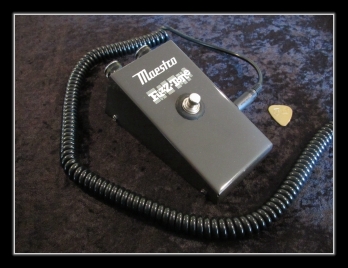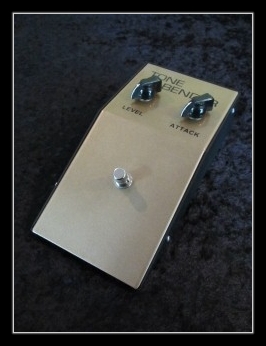

Fuzz Effects Pedals :
By comparison to other types of “gain” effects pedals—such as boost, distortion and overdrive—it is “fuzz” which produces the most intensity. It was also, the very first of its type commercially marketed to the general public during the 1960s. As such, both novice and professional electric guitarists had thus discovered its ability to provide greater sustain; allowing their musical notes to achieve a “singing” quality. Relatively, guitar players were then beginning to change the manner in which music was created. Ultimately, as result, “psychedelic” music had been introduced—though, initially, such was not the case . .
Even though, the year 1962 introduced the first commercial “fuzz” effects pedal (Maestro Fuzz-Tone/ FZ-1), manufactured by Gibson Musical Instruments, such was not widely-accepted among the guitar playing community until Keith Richards (of the Rolling Stones fame) had employed the Fuzz-Tone to help create the 1965 hit single, “Satisfaction”. Prior to 1965, the fuzz-laden sound had actually been heard on other professional recordings as well. For example, early genres of Country and Surf music (respectively, Marty Robbins 1961 hit single “Don’t Worry”, and the Ventures “2000 Pound Bee”—the former, being that of a “fuzzy” sound created from a broken channel of a tube-driven recording console) !

Ultimately . . the simultaneous, commercial success of both the Maestro Fuzz-Tone effects pedal and the song “Satisfaction”, had initially lead to other manufacturers producing their own brand of “fuzz”—particularly, that of the Sola Sound Tone Bender Mk1 (from London, England). Relatively, some of the more notable English artists as Jeff Beck, Paul McCartney, Pete Townsend, and Mick Ronson (respectively, the Yardbirds, the Beatles, the Who, and the Rats fame) had originally employed the Tone Bender Mk1 to help usher-in the psychedelic genre of music. Whilst, in America @ that time (1965), the “fuzzy” sound from the Maestro Fuzz-Tone was generally the only option to consider.
Moreover, during the 1960s, electric guitar sounds originating from America and England were considerably different from one another, relative the guitar amplifiers being used (Fender, Marshall, and Vox). For example, both Marshall and Vox amps from the UK were capable of producing higher gain (more distortion), as oppose to that of the Fender brand from the USA (clean/ linear). Ultimately . . when “fuzz” is blended with a vintage-style over-driven TONE (i.e., Marshall, or Vox), the result is the essence of the psychedelic sound. Click here to learn more about guitar amplifiers.
To help clarify the understanding between the differences of boost, overdrive, distortion, and fuzz effects is as follows :
* Boost : Least amount of gain produced out of the four aforementioned types of effects pedals (i.e., greater note articulation).
* Overdrive : Increased gain, as compared to “boost”, and most-commonly employed by electric guitarists (i.e., greater sustain).
* Distortion : Further-increased gain, as compared to “overdrive”; ultimately, saturating the audio signal arriving from the electric guitar.
* Fuzz : Capable of producing the most saturation, in relation to the aforementioned effects pedals—creating a square wave audio signal, as result.
Epilogue :
Today, all four types of “gain” effects are popular among the electric guitar community—incl. that of collectors, enthusiasts, and musicians.
This Website :
The intention of fuzz-effect-sounds-and-more.com is to provide a reference resource; virtually sharing my gear collection, so that readers are made greater-aware of particularly good-sounding (and, in some instances), potentially collectible effects pedals. Otherwise, to also help those whom might benefit from my recording/ engineering techniques. Ultimately, as I continue to build and design this site, I will gradually introduce additional collection-based content—such as blog posts, image galleries, audio, video, and official manufacturer web links for your convenience. The information provided herein, is based upon biased opinion. Please, do your own research.
Ebooks :
Later . . I will offer for sale Part 1 of a series of self-authored eBooks, in relation to fuzz effects pedals; subsequently, also offering additional volumes regarding other effects types—boost, overdrive, distortion, etc—all via my private, independent collection. Moreover, these tomes of tone will include audio examples, color images, (in most cases) close-up circuit views, and generalized spec. information. Otherwise, said eBooks regarding fuzz effects pedals will additionally incl. generalized historical information as well. For details, please read this site’s eBook advertisement page.
THANKS for your interest of fuzz-effect-sounds-and-more.com
– Michael.
Disclaimer of Copyright & Trademark :
Product names, trademarks, and artists’ names (incl. the names of builders and designers) referred to, and/ or depicted herein are the property of their respective owners, which are in NO way associated or affiliated with fuzz-effect-sounds-and-more.com. Said, names and trademarks are used solely to identify products whose sounds were studied during the audio production efforts for this reference resource. The use of said, names and trademarks does NOT imply any cooperation or endorsement. NO copyright, nor trademark infringement intended. Any errors, omissions or variations in the subject-matter details are unintentional.
Disclaimer of External Web Links :
EXTERNAL web links are provided as a convenience, and for informational purposes only; they do NOT constitute an endorsement or an approval by fuzz-effect-sounds-and-more.com of any of the products, services or opinions of the corporation or organization or individual. fuzz-effect-sounds-and-more.com bears NO responsibility for the accuracy, legality or content of the external site or for that of subsequent links. Contact the external site for answers to questions regarding its content.

This Website & Its Contents : Copyright © fuzz-effect-sounds-and-more.com